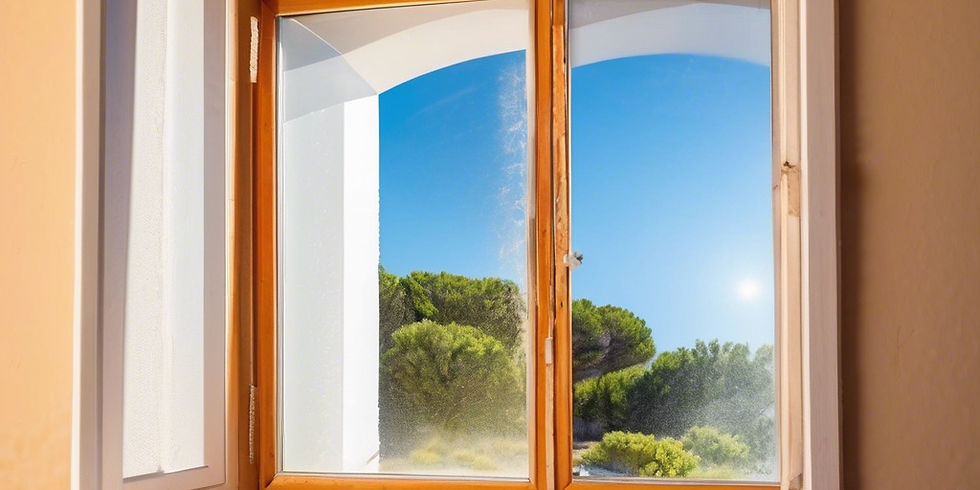Window Condensation in Portugal: What Causes It & How Aluminium Glazing Helps
- Charlie

- Jul 28
- 4 min read
Window condensation is more than just an inconvenience—it's a clear sign that your home's glazing system isn't performing optimally. In Portugal's diverse climate, from the humid coastal regions of Porto and Faro to the temperature extremes of inland areas, condensation on windows affects thousands of homeowners. Understanding why it happens and how modern aluminium glazing solutions can eliminate this problem is crucial for maintaining a comfortable, healthy home environment.

Why Condensation Happens: The Science Behind Moisture on Windows
Condensation occurs when warm, humid air comes into contact with a cold surface—in this case, your window glass or frame. The air can no longer hold its moisture content, causing water droplets to form. This process is governed by the dew point, the temperature at which air becomes saturated with water vapour.
In Portuguese homes, several factors contribute to condensation:
Humidity sources include cooking, showering, breathing, and even houseplants. A family of four can produce up to 12 litres of moisture daily through normal activities.
Thermal bridges in older window systems create cold spots where condensation forms. Traditional single-glazed windows or poorly insulated frames act as thermal bridges, allowing heat to escape and creating cold surfaces.
Poor ventilation traps humid air inside, especially in modern homes that are well-sealed but lack adequate air circulation systems.
Coastal vs Inland Homes: What Makes the Difference?
Portugal's geography creates distinct condensation challenges:
Coastal regions like Porto, Lisbon, and Faro experience higher baseline humidity levels due to proximity to the Atlantic Ocean. Sea air carries moisture inland, creating conditions where condensation forms more readily. Homes within 10 kilometres of the coast often experience 60-80% relative humidity, well above the 40-50% comfort range.
Inland areas face different challenges. Places like Bragança or Évora experience greater temperature variations between day and night, creating conditions where warm, humid indoor air meets cold window surfaces during cooler periods.
Altitude effects compound these issues. Mountain regions experience more dramatic temperature swings, while valleys can trap humid air, creating microclimates that promote condensation.
How Aluminium Frames with Thermal Breaks Reduce Moisture
Modern aluminium glazing systems with thermal breaks represent a significant advancement in condensation prevention. The thermal break—a non-conductive material like polyamide inserted between the interior and exterior aluminium sections—prevents heat transfer through the frame.
Temperature equalisation occurs when thermal breaks maintain the interior frame temperature closer to room temperature, reducing the likelihood of condensation formation. This is particularly effective in Portugal's climate where exterior temperatures can vary significantly from interior comfort levels.
Structural benefits of aluminium frames include superior stability and precision fitting, which ensures consistent performance of seals and weatherstripping. Unlike timber frames that can warp or uPVC that can expand and contract, aluminium maintains its shape, preserving the integrity of the glazing system.
Durability in coastal environments makes aluminium particularly suitable for Portuguese homes. Marine-grade aluminium alloys resist corrosion from salt air, maintaining their thermal performance over decades.
The Role of Double/Triple Glazing & Low-E Coatings
The glass specification plays a crucial role in condensation prevention:
Double glazing with a 16-20mm air gap provides significant thermal insulation compared to single glazing. The inner glass surface maintains a higher temperature, reducing condensation risk. In Portugal's climate, quality double glazing can reduce condensation incidents by 80-90%.
Triple glazing offers superior performance for challenging locations. The additional glass layer and two insulating cavities create an even more stable temperature profile. While more expensive, triple glazing is worthwhile for homes in extreme climates or where absolute comfort is required.
Low-E coatings reflect heat back into the room while allowing light transmission. These microscopically thin metallic coatings, applied to glass surfaces, can improve thermal performance by 20-30% compared to standard glass.
Gas fills like argon or krypton in the glazing cavities enhance insulation performance. These inert gases conduct heat less readily than air, further improving the thermal barrier.
DIY Checks vs When to Get Professional Help
Homeowners can perform several diagnostic checks:
Visual inspection involves checking for condensation patterns, noting when and where it occurs. Interior condensation suggests inadequate insulation, while condensation between glass panes indicates seal failure.
Humidity monitoring using digital hygrometers helps identify problem areas. Readings consistently above 60% indicate ventilation issues that contribute to condensation.
Temperature measurement of window surfaces using infrared thermometers can reveal thermal bridges and cold spots.
Professional assessment becomes necessary when:
Condensation persists despite improved ventilation
Structural damage like rot or mould appears
Energy bills increase significantly
Comfort levels remain poor despite heating system improvements
Professional glazing specialists can perform thermal imaging surveys, measure air leakage rates, and recommend comprehensive solutions.
Frequently Asked Questions
Is window condensation dangerous?
While not immediately dangerous, persistent condensation can lead to mould growth, structural damage, and poor indoor air quality. Mould spores can trigger respiratory issues, particularly in children and elderly residents. Addressing condensation promptly prevents these health and structural concerns.
Do aluminium windows sweat more than uPVC?
Traditional aluminium windows without thermal breaks conduct more heat than uPVC, making them more prone to condensation. However, modern thermally broken aluminium systems perform comparably to or better than uPVC while offering superior durability and aesthetics.
Can ventilation alone solve condensation problems?
Ventilation helps but rarely eliminates condensation caused by thermal bridges. A comprehensive approach combining improved glazing, thermal breaks, and adequate ventilation provides the most effective solution.
How quickly do thermal break windows eliminate condensation?
Most homeowners notice immediate improvement, with condensation significantly reduced within days of installation. Complete elimination typically occurs within the first heating season as the building fabric adjusts to the improved thermal performance.
Window condensation in Portugal requires a systematic approach combining improved glazing technology with proper ventilation strategies. Modern aluminium glazing systems with thermal breaks, quality glass specifications, and professional installation provide lasting solutions that improve comfort, reduce energy costs, and protect your home's structural integrity. For expert assessment and installation of condensation-eliminating glazing systems, contact AltaGlaze's experienced team.




Comments